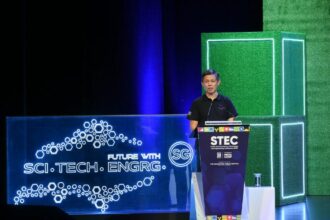The expectations of employees at the workplace have changed and organizations are aware that there is a need to shift how they operate. Employees now want the flexibility to log in easily anytime, from anywhere, and with ease through technology. To enhance employee experience, organizations must be agile in adapting to changes through workplace transformation. To talk about this, we connect with Steven Loh, the Senior Sales Director and Head of Relationship Segment at Lenovo Malaysia.
Steven Loh leads Lenovo Malaysia’s enterprise sales team to serve a range of customers from global to local accounts from both the private and public sectors. He is responsible to cover the full spectrum of providing end-to-end solutions for Lenovo’s commercial products for large-scale business implementations. Having been in the technology sales industry for almost two decades, Steven also employs Lenovo’s “Intelligent Transformation” philosophy to work with his team to drive smarter innovation in transforming enterprises and verticals such as the education sector. Steven leads his team to ensure that they provide Lenovo’s services and solutions today so everyone can benefit from a better tomorrow.
Today, Steven talks about how companies can turn to technology to manage the complete needs of establishing a hybrid workforce.
MIA: With Malaysia adjusting to the endemic phase, why must organizations now consider workplace transformation more than ever?
Steven: As COVID-19 restrictions have eased and offices have reopened, business leaders are excited to get staff back into the office. However, employees’ expectations of the workplace have changed. They want the flexibility to log in easily anytime, anywhere, and focus on the work that matters without having to wrangle with tech issues. Hence, organizations need to step up implementing digital strategies to keep up with the change and improve their work environment for employees.
With that, workplace transformation becomes a key to responding to the disruption of workflow within the business ecosystem and employee experience. The introduction of new technology and processes in the company will support streamlining tasks and enhance the way employees interact at work.
MIA: What are the challenges that organizations face when deciding to take the first step in transforming their workplace?
Steven: It is no easy task for a business to take the first step to transform its business. This first step is daunting and poses many challenges for leaders. What is tougher is that all of this must happen while maintaining business continuity, ensuring productivity and employee satisfaction.
- Lack of understanding of their business needs and unsure of which technology to adopt – To be able to adopt new technology that transforms the business and the way you work; businesses must first understand their business challenges. A business needs to identify the end goal when implementing workplace transformation; whether it is to optimize productivity, increase employee communication and collaboration, or increase flexibility to work from anywhere.
- Existing infrastructure and systems in place – Most businesses already have legacy systems and long-standing IT infrastructures that are already in place. Employees are well accustomed to these systems, and this becomes a barrier for businesses as they become reluctant to move to new platforms. With adopting new systems, retraining becomes a concern for leaders as well – with increased time spent on learning the new systems and the need to retrain staff.
- Budget Constraints – Workplace transformation is not a cheap investment to make for businesses. Without clarity on the right tools and technology to acquire that meet the businesses’ goals, businesses may be challenged with spending too much or having the need to increase their budget.
MIA: How can CIOs better manage their organizations in a hybrid working environment?
Steven: According to a recent global research study from Lenovo that was conducted with CIOs, it was reported that about 82% of CIOs shared that their role has become more challenging; CIOs are responsible for the entire technology value chain from navigating the tech ecosystem, upskilling employees and beyond. CIOs are now managing areas beyond their traditional purview, including HR and talent acquisition. Tasked with these additional responsibilities, CIOs need cohesive technology solutions and services that will free up their time from the maintenance and upkeep of IT. This enables them to focus on more strategic imperatives such as building an attractive workplace because of an increasingly hybrid workforce.
For CIOs to make this shift, businesses need to engage an expert to evaluate business solution needs – Employing an expert can help evaluate the business needs and the type of solutions that would work best for the business. This helps reduce the concerns of the business owners and ultimately, saves them from investing in the wrong technology. As a solutions and services provider, Lenovo is aware of the challenges that businesses face and is a valuable partner for businesses by providing end-to-end support from consultation, deployment, and technical support.
MIA: What should CIOs consider when adopting workplace transformation?
Steven: According to Lenovo’s The Future of Work study, most workers adapted well to remote work during the pandemic – 70% say the flexibility leaves them overall more satisfied with their job. More employees prefer the flexibility of working remotely, and this sentiment increases among those in larger organizations. Since employees in larger companies tend to work with teams across continents and time zones, the physical office is less relevant for effective collaboration.
To attract and retain talent, unleash creativity, and encourage collaboration, workplaces must become smarter. The design of a workplace must begin with employee support being top of mind, which may mean rethinking the role of the office and the tools that will help employees sustain their choice of work arrangement. Leaders also must ensure that employees have the tools to work remotely at ease. Modern building access, simple space booking, and improved ways to communicate and collaborate are convincing steps forward for employers to take.
Shifting to compete in a digital world is a major challenge for many businesses – transforming your business is not a simple task and this cannot happen overnight. Hence, CIOs must outline a transformation roadmap so that businesses can transform their workplace in a more cost-effective, efficient, and sustainable manner.
A transformation roadmap is a guide for CIOs in deciding what type of technology they should invest in, how they should steer forward, and the milestones that they need to achieve to ensure a successful implementation. There are several stages that businesses must look to frame in their roadmap:
- Evaluation of the Business – Businesses must first evaluate the overall standing and operation of a business – CIOs must identify the objectives in driving work transformation, the current challenges that the business is facing, and the readiness of the businesses to adopt work transformation.
- Setting Your Goals – Once the business’s current standing has been identified, the business must now define the goal to be achieved. This includes, optimizing performance and efficiency, encouraging collaboration between employees, and even enhancing security.
- Identifying The Right Solutions and Tools to Invest – To be able to achieve the set goals, businesses must deploy tools and solutions. It is important that the business also chooses the appropriate partner to support the selection and deployment.
- Implementation by Stages – Transformation does not happen overnight. It is a long-term effort scaled through stages across different business units. To ensure that implementation is carried out smoothly and cost-efficient, transformation must be planned, prepared, and resourced properly.
By following this roadmap, businesses and CIOs will have a clearer view of how they can steer forward.
MIA: How can organizations accelerate their workplace transformation agenda by actively working together with a solutions provider such as Lenovo?
Steven: Organizations can adopt workplace transformation independently albeit with their own set of challenges. However, with a vendor such as Lenovo, businesses can get support in streamlining how they transition efficiently and cost-effectively.
From Lenovo’s global research study with CIOs, it was reported that CIOs believe that technology vendors play an invaluable role in their company’s overall success. 61% of respondents shared that their businesses would feel an impact in no more than a few weeks if they halted spending on digital transformation initiatives, proving that technology is a critical component of the business. As businesses continue to evolve in years to come, CIOs are looking to turn to their vendors to help them solve a myriad of problems including increasing their organizational agility (60%); providing security of their company’s systems and operations (52%); optimizing configuration, deployment, and maintenance of technology (50%); and managing costs (43%).
Lenovo can support CIOs through this journey with technology and services that meet the needs of the employees and environment through Lenovo’s Workplace Solution including –
- Control: Forget the problems of managing multiple vendors and point solutions. Lenovo gives you control, from pre-installation site surveys that configure our solutions to your environment, to global support that can scale across locations.
- Employee engagement: Your employees want to work in an environment that’s both safe and healthy. Modern building access enables a consistent, reliable, and secure experience. And space booking helps your employees relax and get more from their workdays.
- Management: We provide monitoring, maintenance, and service for our workplace solutions throughout their lifecycles.
- Safety: The safety and security of all employees are paramount. From smart access to enhanced communications, Lenovo helps you protect your people – and your business.
- Scalability: We work closely with your teams and our partners to roll out practical enterprise-wide solutions, quickly and consistently.
MIA: What are the bottom-line benefits that organizations can gain from implementing workplace solutions?
Steven: The adoption of Lenovo’s Workplace Solutions portfolio affects the bottom line in a variety of ways including:
- Increased retention – Attracting talents is important in sustaining a business in the long run and the war to hire talents is fierce. Recruitment of talents is becoming difficult, especially with the expectation that employers must be nimble, flexible, and adapt to hybrid and digital working arrangements.
- Increased productivity – To compete in the current market, there is a need for businesses to be agile to be able to produce results fast. It is possible by introducing technology that allows teams to operate efficiently to be fast. This includes introducing real-time collaboration systems and getting rid of traditional working habits by introducing:
- Smart Collaboration: All-in-one meeting room solution with video conferencing software and integrated devices that are easy to use and scale according to meeting sizes, protected by ThinkShield, a suite of security solutions to safeguard users’ privacy and data
- Workspace Booking: Scheduling software offering real-time visibility on workspace occupancy enables employers to manage capacity better, helps employees book facilities quickly to save time, and improves contact tracing with automated post-event reporting
- Reduced or manage expenses efficiently – Businesses can understand the usage of their physical workspace and make informed decisions on what they should continue investing in and costs that can be reduced:
- Workplace Analytics: Delivered via a dashboard providing real-time insights on space usage, based on non-invasive data from heat and motion sensors; helping businesses decide if they need to downsize space or introduce more IT tools and infrastructure to empower productivity wherever employees are.
- Health & Security – Ensuring that employees’ welfare and data are kept safe at all times is vital.
- Enterprise security: Protect your data, hardware, and software to ISO 27001 standard, among other leading certifications; pre-configured with Activity Directory and Microsoft connectors.
- Visitor Management: The system simplifies the visitor registration process and health check-in forms, drastically reducing waiting time and improving the overall visitor experience.
- Smart Locker: Flexible self-service storage service enabling employees to store, pick up and drop off assets securely 24×7 with minimal fuss and reduced waiting time.
- Enhance workplace security: Seamless integration with turnstile gate and door lock control system enhances the safety and security of the workplace
MIA: What advice would you like to give organisations that still insist on conventional work arrangements post-pandemic, given that some employees are pushing back as they were productive while working from home? Perhaps can elaborate on its advantage and disadvantage of it.
Steven: Our advice for CIOs and businesses would be to introduce changes gradually. This would help employees to adopt a comfortable and sustainable approach. Keeping to current legacy systems and current work arrangements may seem like the safest choice for most businesses – there is minimal disruption to workflow and processes are kept in place.
However, businesses that are resistant to change, may struggle to acquire new talents. According to Gartner’s “Future of Work Reinvented” study, it was reported that 55% of employees and 65% of IT employees shared that work flexibility will impact if they stay at their current jobs. Most workers these days favour hybrid working and believe that this is an important aspect for them.
The Gartner study also shares that human-centric work design, featuring flexible work experiences, can increase employee performance by as much as 54%. Businesses that do not adapt may face continuity challenges in the long run; affecting a business’s ability to be agile and will lag especially in the event of disruptions.
About Steven Loh, Senior Sales Director, Head of Relationship Segment, Lenovo Malaysia
Steven Loh leads Lenovo Malaysia’s enterprise sales team to serve a range of customers from global to local accounts from both the private and public sector. He is responsible to cover the full spectrum of providing end-to-end solutions for Lenovo’s commercial products for large-scale business implementations. Having been in the technology sales industry for almost two decades, Steven also employs Lenovo’s “Intelligent Transformation” philosophy to work with his team to drive smarter innovation in transforming enterprises and verticals such as the education sector. Steven leads his team to ensure that they provide Lenovo’s services and solutions today so everyone can benefit from a better tomorrow.












